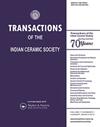用皮革废料合成含铬陶瓷颜料
IF 1.5
4区 材料科学
Q3 MATERIALS SCIENCE, CERAMICS
引用次数: 5
摘要
以煅烧的皮革废料和工业级金属氧化物为原料,采用固相反应法制备了蓝绿和黑色两种不同颜色的陶瓷颜料。利用x射线荧光(XRF)对废皮革的化学成分进行了表征,确定了废皮革的化学成分,表明煅烧后的废皮革可作为铬前驱体体系制备陶瓷颜料。采用XRD、SEM、紫外可见分光光度计和全自动比色仪分别对陶瓷颜料的晶体结构、微观结构、吸收光谱和比色坐标进行了表征。釉上实验证明,所制颜料具有良好的稳定性和显色性能。当焙烧皮革的质量分数为45 wt%时,其黑色显色效果最佳(L*=9.95),而蓝绿颜料的显色性能与Al2O3的添加量有关。该工艺方案绿色环保,对资源循环利用、经济社会可持续发展具有重要意义。图形抽象本文章由计算机程序翻译,如有差异,请以英文原文为准。
Synthesis of Ceramic Pigments with Chromium Content from Leather Waste
Two different coloured ceramic pigments, blue-green and black, were prepared by using solid phase reaction method from calcined leather waste and industrial grade metal oxides. Chemical compositions of leather waste were characterized by X-ray fluorescence (XRF) in order to determine their chemical compositions, which indicated that the calcined leather waste could be used as a chromium precursor system to prepare ceramic pigments. Crystal structure, microstructure, absorption spectra and colorimetric coordinates of ceramic pigments were characterized by XRD, SEM, UV- vis spectrophotometer and fully automatic colorimeter, respectively. Glaze experiments proved that the as-prepared pigments had good stability and excellent colour development performance. In addition, it was found that the best black colour rendering effect (L*=9.95) occured when the content of calcined leather was 45 wt%, however, the colour rendering performance of blue-green pigments was related to the amount of Al2O3 added. The process scheme is green and environmentally friendly, which is of great significance to resource recycling, sustainable economy and social development. GRAPHICAL ABSTRACT
求助全文
通过发布文献求助,成功后即可免费获取论文全文。
去求助
来源期刊

Transactions of the Indian Ceramic Society
工程技术-材料科学:硅酸盐
CiteScore
2.40
自引率
8.30%
发文量
12
审稿时长
2.3 months
期刊介绍:
Transactions of the Indian Ceramic Society is a quarterly Journal devoted to current scientific research, technology and industry-related news on glass and ceramics. The Journal covers subjects such as the chemical, mechanical, optical, electronic and spectroscopic properties of glass and ceramics, and characterization of materials belonging to this family.
The Editor invites original research papers, topical reviews, opinions and achievements, as well as industry profiles for publication. The contributions should be accompanied by abstracts, keywords and other details, as outlined in the Instructions for Authors section. News, views and other comments on activities of specific industries and organizations, and also analyses of industrial scenarios are also welcome.
 求助内容:
求助内容: 应助结果提醒方式:
应助结果提醒方式:


